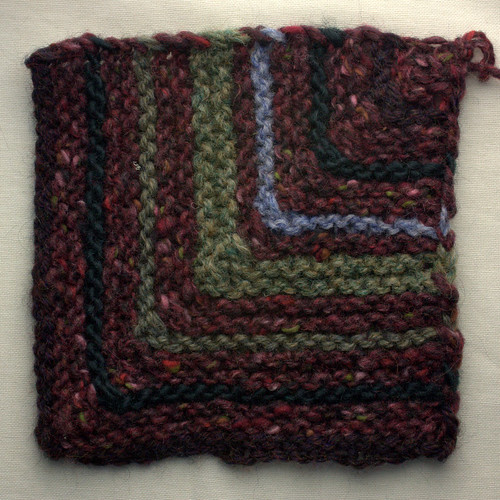
A few weeks ago I had to run a Saturday morning errand to Acton. Danny was in the car with me. We saw a yarn store on the main street so I suggested we go in. I came out with one new skein for the blanket, this deep burgundy Debbie Bliss Donegal Aran Tweed. I've used it already in one or two squares, but wanted to base a square around it. Nothing came immediately to mind so this week I started knitting to see what would happen.
Within the first two rows I began to think of a red mulberry tree (Morus rubra) that grew beside the house where I grew up. Typically red mulberries are small trees growing in the understory, but ours was about 15 metres tall with a girth so large an adult could barely reach halfway around. Originally two of them stood a few paces apart, but one got hit by lightning when I was too young to remember.
The mulberry was a grand tree. Its strong, spreading limbs shaded the south side of our house. It was a great climbing tree. My brother built a fort in it when I was very small, and I continued to use it. My cousin, Bill, used to fall out the tree regularly and broke his arm on at least one occasion.
We had a grey cat named Smudge who thought she was a monkey. She mostly stayed indoors through the winter, but on the first mild spring day she would scramble into the mulberry and leap from branch to branch. Our older cat, Grey Shadow, preferred to lie in the soft, cool shade on the platform of the treefort.
It produced bountiful fruit in midsummer, which were small and insipid, but attractive to many birds such as cedar waxwings. Our patio and the soles of our feet would become stained purple.
The tree also attracted one of the large North American silk moths, the cecropia moth, Hyalophora cecropia. We never saw caterpillars, but sometimes in fall or winter we would find large pale brown cocoons attached to a branch or the trunk. One year we tried bringing one indoors, and the gorgeous moth emerged one sunny winter day. It lived for a few days but we could not release it. That was a sad lesson for us, and we left the cocoons alone afterward.
Our house had a deck off the second-floor bedrooms, and I used to be able to climb between the deck and a branch of the mulberry to get up or down. Sometimes as a teenager I would slip out of my bedroom and down the tree just to roam around in the dark.
After I left home for university, the tree suffered the same fate as its sibling and was destroyed by lightning. There used to be a few saplings around the woodsy edge of the vacant lot next door, but I have not seen one there for many years. I never saw another big mulberry until recently—in Toronto one of the cafés on Queen Street has a tall tree casting shade over the back patio.
We had no idea what a special tree ours was. Now I know red mulberries are endangered in Canada, confined to the most southerly part of the Carolinian Forest zone in Southwestern Ontario.








